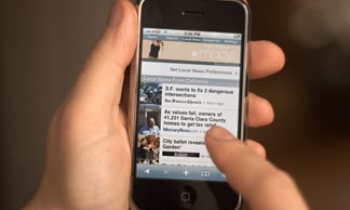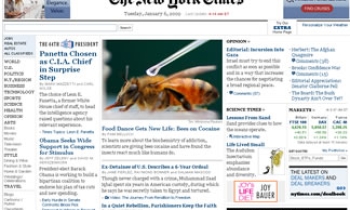Chances are you won't bother to read this article. It is just one long block of text, after all, unbroken by alluring pictures, snappy captions, or eye-grabbing infographics. You can't click it. You can't flip it. All you can do is read it.
And reading a full magazine article – as opposed to scanning, perusing, surfing – is so twentieth century, so retirement home, so William Shawn.
Hal Espen, the editor of Outside, has gone even further, promising free beer and bikinis to anyone with actual evidence that bite-size morsels will replace long magazine journalism. The future of magazine writing, at least according to the latest buzz, resides elsewhere. You can see it in the blurbs of catalogs like InStyle and Lucky, the picture captions from Us Weekly, or the short-form collages of Maxim, Blender, and more recently, Rolling Stone. "Consumers who actually open a magazine at the front and commence reading are becoming an increasingly rarified demographic group," David Carr tells us in The New York Times. "The long-form narrative may become just one more fetish, no more or less worthy of a magazine than sub-zero refrigerators or B-list starlets."
Promoters of the short attention span have already declared victory. "If you are trying to reach cranky retirees, maybe six-thousand-word rants are appropriate," Maxim's editor, Keith Blanchard, said this summer. "Our readers" – mainly young men and nearly eleven million strong – "are busier today then they will ever be in their lives; they have shorter attention spans than any previous generation; they are chronically over-stimulated and easily bored."
Over at Rolling Stone, once a paragon of long-form innovation, editor Ed Needham admits that he doesn't even bother to read long articles in magazines. "People just don't have as much time to read," he told USA Today. His boss, Jann Wenner, seems to agree. "Back when Rolling Stone was publishing these seven-thousand-word stories, there was no CNN, no Internet," Wenner told the Times. "And now you can travel instantaneously around the globe, and you don't need these long stories to get up to speed."
The magazine-reading future, in other words, will be bite-sized. The narrative will surrender to the newsflash. Image will subsume the written word. It is already happening. It can't be stopped. As Simon Dumenco recently announced in Folio, "The magazine is dead, long live the magazine."
Skeptical? Still reading? For months now, some editors have been battling this buzz, struggling to refocus the terms of the debate and dispel myths, lest advertisers and readers start to believe them. James Kaminsky, a former Maxim executive editor, made a point of breaking ranks with his laddie-magazine peers when he was named editor of Playboy in September. In interview after interview, he committed himself to continuing Playboy's long stories. "This is one of those theories that has been in the air," Kaminsky said of the buzz. "I would love to see it disproved. In fact, I plan on disproving it."
Hal Espen, the editor of Outside, has gone even further, promising free beer and bikinis to anyone with actual evidence that bite-size morsels will replace long magazine journalism. "I say this attention-span stuff is an urban legend," Espen wrote in a recent Internet posting on Jim Romenesko's MediaNews. "Where's the research that tells guys like Blanchard, not to mention Jann Wenner and Ed Needham, that an epidemic of young adult ADD is shaping a new-reader paradigm?"
So what is the future of the long-form article? Who is right? Blanchard or Kaminsky? Wenner or Espen? Does size matter? The answer is far more complicated and hopeful than the public discussion has so far allowed.
No one can deny the visual sea change that has overtaken the magazine industry in the last three decades. Most magazines now resemble movie posters more closely than they do the dry pages of a book. They are filled with color, oversized headlines, graphics, photos, and pull quotes. The gray text page, once a magazine staple, has been all but banished by a new breed of art directors who have gradually made their way up the masthead. "They have reduced the amount of text and increased the pictures boxes, and captions," says Roger Black, the chairman of Danilo Black, who has redesigned dozens of magazines. "Thirty years ago it was a major effort to get anybody to think about that."
Despite such changes, the percentage of young readers for trademark titles has continued to erode. MediaMark Research, which tracks magazine readership, has noted a steady decline over the last twenty-six years in the percentage – and number – of readers between the ages of eighteen and thirty-four for whole categories of magazines, including the newsweeklies (Time, Newsweek, U.S. News & World Report) and long-form titles (The Atlantic Monthly, The New Yorker). Between 1986 and 2002, the share of newsweekly readers under the age of thirty-five dropped from 44 to 28 percent. The share of young long-form readers dropped from 39 to 20 percent.
Over the decades, younger magazine readers have also become less likely to read at home. The share of newsweekly consumers who read somewhere else, for example, has steadily increased since 1986, from 61 percent to 70 percent for readers under thirty-five. On average, younger readers are also spending less time with each issue. This problem is acute at the Atlantic and The New Yorker, where average reading time for ages eighteen to twenty-four dropped from forty-three minutes an issue in 1990 to twenty-nine minutes in 2002, a change that was not reflected in the older age groups.
The knee-jerk explanation for these changes often blames the young consumer, who allegedly has less time, less attention span, and less interest in anything that is intellectually challenging. But some facts and studies call those assumptions into question. Consider:
- When polled, Americans overwhelmingly say that they feel as if they have less time than ever before. Surveys also show that Americans as a whole are working longer hours, partly because of the increase of women in the workplace. But when pollsters ask for specific breakdowns of how Americans spend their week, the answers change. For twenty-two years, the Harris Poll has asked Americans each year to estimate their weekly leisure time. The average response has remained constant: roughly twenty hours a week. Since 1965, the University of Maryland has asked Americans to keep a daily time diary of their free time – defined as everything but the time spent working, caring for one's family, or caring for oneself. The response: free time increased from an average thirty-six hours a week in 1965 to forty-four hours a week in 1995. Incidentally, young men are generally at the top of this free-time pile, since many are still single and in school, affording them more unscheduled time.
- There is little evidence to suggest increased television viewership is killing off reading. When asked by Harris to describe their top leisure-time activities, Americans still regularly put reading at the top of the list (28 percent of those polled in 2001), outscoring even the boob tube (20 percent). Nor has increased television viewing sapped the time we spend reading, according to time-diary studies. While the average time spent reading a newspaper declined dramatically between 1965 and 1995, "all other reading, including books and magazines, is increasing," reports John P. Robinson, a professor at Maryland, who authored the study.
- Long narratives, in the form of books, remain popular with young people. A separate 1999 Gallup poll found book readership rates essentially unchanged over the previous two decades. Fifty-six percent of eighteen- to twenty-nine-year-olds read six or more books a year, compared to 62 percent of those ages fifty to sixty-four. Of adolescents ages twelve to eighteen, 56 percent reported reading ten or more books in the year, according to another poll by the National Education Association in 2001. Polls by the Pew Center for the People and the Press have come to similar conclusions. Young people read books and magazines at roughly the same rates as older Americans, though men in this category tend to lag behind women.
So why aren't magazine readers, especially young ones, picking up long-form magazines in droves? One reason may be found in the changing magazine – and media – landscape. Magazine consumers may still have a great appetite for reading, and more time than is generally realized, but they also have far more choices.
"The total circulation has been flat for the last ten years, even though the number of magazines has increased 40 percent," explains Dan Capell, the magazine industry's leading circulation consultant. Encouraged in the late 1990s by a healthy ad market, publishers have also artificially inflated their circulation with cheap subscriptions. "You get subscribers who are not really interested in your magazine," Capell explains, pointing out that renewal rates dropped to 46 percent last year, the worst in five years. Editors have been forced to design their magazines for an indifferent reader, according to Michael Wolff, media columnist for New York. "We've shoved magazines down the throats of people," Wolff said. "They flip through magazines because they don't really want them."
Other forms of media have experienced the same explosion of choices. The number of television channels, the number of published books, the number of Internet sites, and the number of information technologies have all skyrocketed in recent decades. But there are still only twenty-four hours in a day. The barrage of options may be one reason that more free time feels like less. "It's almost like standing under a fire hose and trying to figure out how to get a drink of water," says J. Walker Smith, president of Yankelovich, Inc., a market research firm.
Still reading?People have responded to this growth by increasing the daily time they spend with all types of consumer media, adding an average forty-five minutes of media time per day between 1996 and 2002, according to one study. Nonetheless, the increase in options has made it more essential for magazines to win readers' attention.
" It is absolutely critical these days to reach out and grab the reader," says Playboy's Kaminsky. In his view, this means stories should still go long, but they need to be packaged with numerous "access points" – the industry jargon for short sidebars, photographs, and graphics. When he was at Maxim, Kaminsky was able to successfully test his theory by running regular 4,000- to 5,000-word features on such heady subjects as the sinking of the Russian submarine Kursk. Despite Blanchard's blustery putdown of long-form this summer, Maxim still runs such stories.
In addition to grabbing attention, the explosion of choices parallels a fragmentation of consumer tastes. This has had another effect on magazines like Rolling Stone, an effect that is often confused with a declining interest in long articles. Back in Rolling Stone's heyday in the '60s and '70s, the magazine had a near monopoly on the music and focus of youth. Today, however, "there is no pervasive music that all the kids are listening to," says Black of Danilo Black. "It's a granular culture."
In a granular culture – filled with punk, post-rock, hip hop, electronic, and country – Rolling Stone traded its rock roots for bubble-gum pop just to keep its mass-market share, with four Britney Spears covers in the last three years. The new Rolling Stone seeks to solve that problem in another way, by increasing the number of stories it runs while decreasing their length, a tactic that more closely resembles the Internet than a book. This tactic, pioneered by Blender, offers more to a wider spectrum of readers, with 100 or 200 album reviews in each issue. In place of a long narrative, the readers create their own story as they pick and choose their way through the magazine. "It's not about your narrative," says Black. "It's about me."
Notice, however, that this loss of a mass audience says nothing definitive about interest in long stories, and has little to do with Wenner's questionable notion that a faster news cycle decreases the need for in-depth articles. Similarly, the success of Maxim also says little about a declining interest in long articles. While Maxim has lifted advertising dollars from other magazines, there is little evidence that it is bleeding off many readers. "The numbers demonstrate that we are not pulling guys away from other magazines," notes Blanchard. "We're getting guys who weren't reading any magazines at all to read magazines."
In many ways, Maxim has more in common with a long-form title like Esquire than one might expect. In 1933, when Esquire came out, it sold out within weeks and was quickly denounced by critics for its "unholy combination of erudition and sex." But the new magazine struck a chord just as Maxim would years later, with an edgy, funny tone, sexy pinups, and practical advice about picking up women. While Esquire targeted the would-be sophisticate, Maxim went after man's animal instincts with the same formula. It found an untapped market. As Outside's Espen puts it, "They drove a beer truck into a crowd of thirsty guys." There is nothing stopping those thirsty guys, once quenched, from reading, and little evidence that they won't do just that.
But perhaps the strongest argument in favor of a healthy future for long articles can be found in the past. Magazines devoted to long quality articles have so far withstood unending prophecies of their demise. "When radio started, the thing that a lot of people were saying was 'I don't have time to read,'" says Hugh Merrill, a magazine historian at the University of Alabama at Birmingham. One magazine, Literary Digest, responded in the 1930s by printing the estimated reading time next to its stories, as a way of luring readers. The fad never caught on.
The same concerns about the death of reading were voiced again with the advent of television. Videocassette recorders did not stop people from going to the movies. The phonograph did not spell the end of live concerts. So can broadband technology, an explosion of choice, and the continued cultural drift toward the short and the visual finally put a nail in the coffin? Mark Kramer, a director and writer-in-residence at the Nieman program for narrative journalism at Harvard, offers this metaphor in response. "Even though ninety percent of American eating-out money gets spent on fast food, it doesn't mean there isn't space to open up a gourmet restaurant." Nor does it mean that the less pricey restaurants won't continue to lure customers with occasional high-quality fare.
Gourmet editors like The New Yorker's David Remnick, who recently celebrated a new circulation record, do not seem to be sweating over the new fast food. When asked on a recent radio appearance whether he feared for the future of long stories, his answer was succinct: "There is still and always will be a sizable audience for larger pieces of excellent journalism." As for all the buzz, he said simply, "The secret is not caring.









